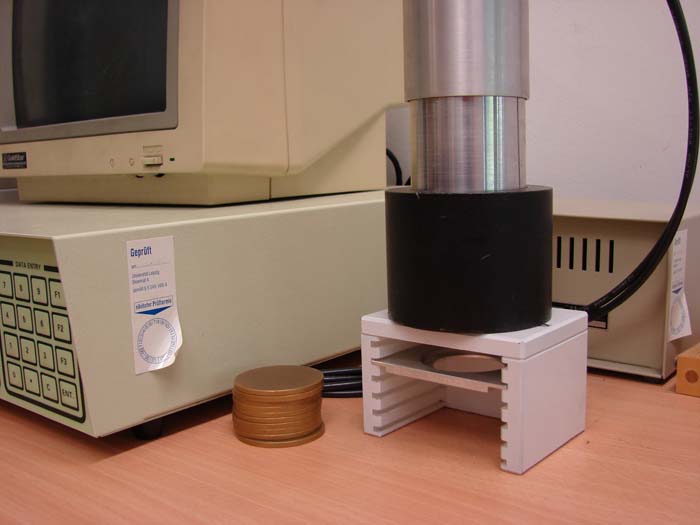ISO 9696 Gross Alpha Activity in Drinking Water
The ISO 9696 standard specifies methods for determining gross alpha activity in drinking water. This service is pivotal for ensuring compliance with international safety standards, particularly relevant for sectors involved in the production and distribution of potable water.
Water is a fundamental resource, essential not only for survival but also for maintaining public health. The presence of radioactive elements can pose significant risks if not properly managed. Gross alpha activity refers to the overall radioactivity resulting from alpha emitters present in a sample. Alpha particles are among the most potent types of radiation due to their high energy and ability to penetrate materials, making them particularly hazardous when they enter the human body.
The ISO 9696 method involves collecting water samples, filtering these through specific media designed to trap radioactive particles, followed by measuring the radioactivity emitted. This process ensures accurate quantification of alpha activity levels, which is crucial for assessing potential health risks and ensuring safe drinking water.
Compliance with this standard is not just a legal requirement but also a testament to a company's commitment to public welfare and environmental responsibility. By adhering to ISO 9696, laboratories can provide reliable data that aids in decision-making processes related to water quality control.
The testing procedure outlined in ISO 9696 involves several steps:
- Sampling: Collect representative samples from different sources of drinking water.
- Preparation: Filter the collected samples through specific media that capture alpha emitters effectively.
- Measurement: Use appropriate instrumentation to measure the radioactivity levels accurately.
The importance of this service extends beyond mere compliance. It plays a critical role in protecting public health by ensuring that drinking water meets stringent quality standards. By adhering to ISO 9696, laboratories contribute significantly to maintaining the trust and confidence of consumers who rely on safe and clean water for their daily needs.
Understanding the broader implications of this service is essential for stakeholders involved in various sectors such as environmental protection, public health, and infrastructure development. Compliance with ISO 9696 helps these entities meet regulatory requirements while also enhancing their reputation and operational efficiency.
Customer Impact and Satisfaction
The implementation of ISO 9696 Gross Alpha Activity testing has a profound impact on customers across multiple sectors. Quality managers can leverage this service to ensure that products meet or exceed specified standards, thereby enhancing product reliability and customer satisfaction.
For compliance officers, adherence to such standards demonstrates commitment to regulatory requirements, fostering trust among stakeholders. This not only bolsters the reputation of organizations but also ensures long-term sustainability by avoiding costly legal repercussions.
R&D engineers benefit from this service through enhanced understanding of potential risks associated with various water sources. This knowledge allows them to innovate and develop safer processes and technologies for water purification.
In terms of procurement, ensuring suppliers meet ISO 9696 standards is crucial in maintaining high-quality supply chains. By integrating this testing into their supplier evaluation process, organizations can guarantee the quality of raw materials used in product manufacturing.
The impact on customer satisfaction extends far beyond regulatory compliance. Ensuring that drinking water meets stringent safety criteria reassures consumers about the integrity and safety of products they consume daily. This trust fosters loyalty and enhances brand reputation, ultimately driving business growth.
Competitive Advantage and Market Impact
The implementation of ISO 9696 Gross Alpha Activity testing provides a competitive edge in several ways. Organizations that adopt this standard early can differentiate themselves by demonstrating their commitment to safety and quality. This proactive approach not only enhances internal processes but also sets a benchmark for industry standards.
From an operational perspective, adhering to ISO 9696 ensures efficient resource utilization and minimized downtime. By identifying potential risks early through thorough testing, companies can avoid costly disruptions and maintain continuous operations.
In the context of market dynamics, compliance with international standards like ISO 9696 opens doors to new markets and opportunities for collaboration. It also facilitates smoother trade relations by aligning with global regulatory frameworks.
The broader impact on society is significant as well. By ensuring drinking water meets stringent quality criteria, organizations contribute positively to public health outcomes. This proactive stance not only improves the immediate environment but also sets a precedent for sustainable practices across industries.
Use Cases and Application Examples
The application of ISO 9696 Gross Alpha Activity testing is extensive and varied, covering various use cases in different sectors. Here are some illustrative examples:
Water Treatment Plants: Regular monitoring using this standard helps water treatment plants maintain optimal levels of alpha activity, ensuring that the treated water is safe for consumption.
Healthcare Facilities: Hospitals and healthcare providers must ensure their water supply meets strict safety standards. ISO 9696 testing ensures that medical facilities provide clean and safe drinking water to patients and staff.
Retail Chains: Retailers with multiple locations can use this service to verify the quality of water provided by suppliers, ensuring consistency in product quality across all outlets.
Agriculture: Agricultural operations that rely on irrigation systems benefit from ISO 9696 testing. It ensures that crops grown using treated water are free from harmful levels of radioactivity.
Environmental Agencies: Regulatory bodies can utilize this standard to enforce compliance and ensure environmental protection measures are effective in reducing radioactive contamination.





